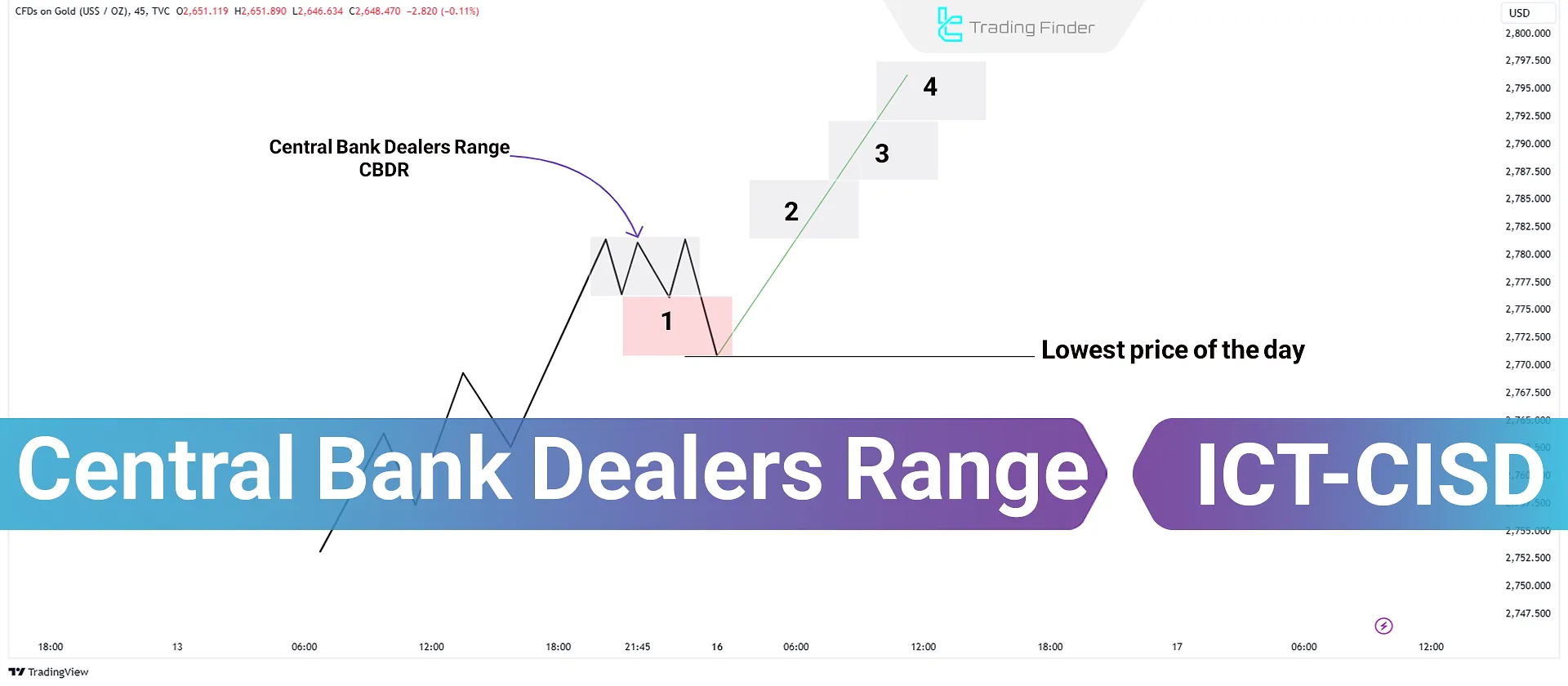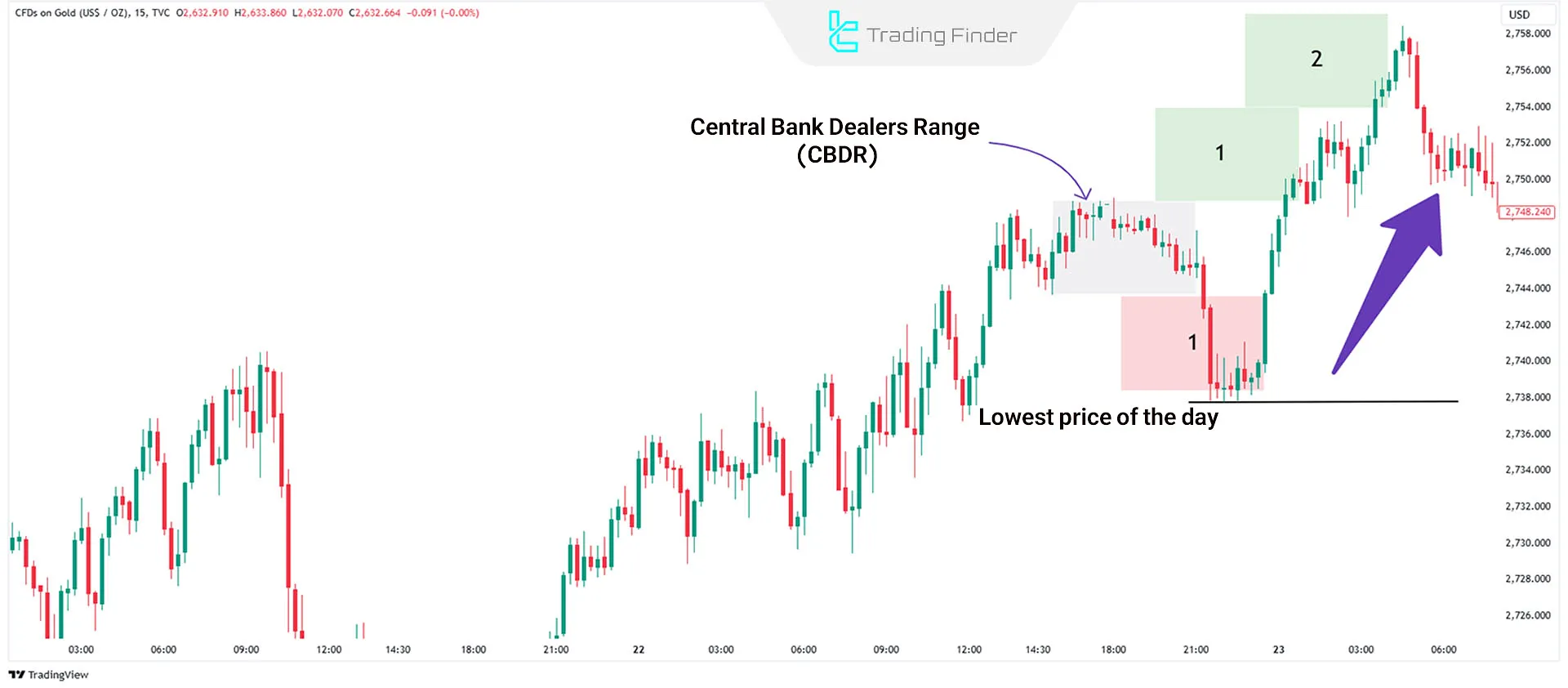The Central Bank Dealers Range (CBDR) represents price stabilization before the market’s major moves. Central banks and large financial institutions use this range to manage liquidity and prepare the market for significant shifts.
CBDR is used to identify breakouts or reversals and guide daily bias in higher timeframes.

What is the Central Bank Dealers Range (CBDR)?
The CBDR price range in ICT Strategy is used to predict a trading day's highest and lowest price. This range is calculated between 2:00 PM and 8:00 PM New York time, and higher or lower ranges can be estimated using specific deviations from the average price.
The range can be expanded by incorporating deviations above and below the average price. Typically, this deviation reflects how prices are dispersedrelative to the mean.
What Range is Ideal for CBDR?
- Range Height: Calculated by finding the highest and lowest price within the specified time. It is preferable to use the candlestick bodies; however, candlestick wicks can be included if the bodies are too small;
- Optimal Range: CBDR should ideally be less than 40 pips, with 10 to 20 pips yielding better results;
- Larger Ranges: Short-term trades tend to perform better if the range exceeds 40 pips.
Advantages of Using CBDR
- Precise Forecasting: CBDR enables traders to predict price movements with greater accuracy;
- Risk Reduction: It supports informed decision-making, avoiding high-risk trades;
- Increased Profitability: Identifying trading opportunities with higher probabilities of success;
- Flexibility: Applicable across various markets and timeframes.
How to Use CBDR in Trading?
Each trading day, the market seeks to move the price at least 1–2 times the CBDR range against the trend in order to collect liquidity.
Then, it moves four steps in the trend direction, equivalent to the daily CBDR range.
Bearish Days
On bearish days, the ideal scenario is for the price to exceed the CBDR range by no more than two units, typically moving just 1 unit up to collect liquidity.
The day's lowest price can be predicted as three units below the CBDR range, typically seen at the end of the London trading session.

Bullish Days
On bullish days, the ideal scenario is for the price to drop no more than two units below the CBDR range, typically moving just 1 unit down to collect liquidity.
The day's highest price can be predicted as three units above the CBDR range, typically seen at the end of the London trading session.

Beside CBDR, ypu can learn how to use other strategies in TradingFinder forex education section.
Which Timeframes Are Suitable for CBDR?
The best timeframes for CBDR are 15-minute and 30-minute intervals:
- 15 Minutes: Ideal for short-term trades, providing a more precise view of price fluctuations;
- 30 Minutes: Better for an overall view and long-term planning.
Which Currency Pairs and Assets Are Suitable for CBDR?
CBDR was initially designed for trading NASDAQ and S&P500 indices. Following its success, this method expanded to other financial markets, including forex and precious metals.
Currency pairs like “GBP/USD” and “EUR/USD” are the best choices for this strategy. Additionally, it has performed well in the gold market (XAU/USD.)
How to Achieve Better Results with CBDR?
To succeed with CBDR, traders should focus on the following principles:
- Precise identification of the CBDR range;
- Risk and capital management;
- Analyzing news and market conditions;
- Exercising patience and trading under ideal conditions.
What Role Do Central Banks Play in CBDR?
Central banks and smart money significantly influence the CBDR and its formation:
- Interest Rate Decisions: Cause changes in price volatility and the CBDR range; You can be aware of these changes by using TradingFinder Central Bank Interest Rates Tool
- Monetary Stimulus Actions: Affect price ranges by increasing or decreasing liquidity
- Currency Interventions: Lead to sudden changes in the CBDR range
Which Days of the Week Are Best for CBDR?
- Tuesdays and Wednesdays: These days often mark weekly highs or lows, offering more opportunities for CBDR-based trades;
- Days with Significant Economic News: High-impact news releases (e.g., interest rate decisions, employment reports, or inflation data) can create volatility, driving prices toward CBDR targets;
- Overlap of Trading Sessions: The overlap between London and New York sessions, known as the kill zone, offershigh volume and suitable trading opportunities.
Conclusion
The Central Bank Dealers Range (CBDR) is designed to identify price highs and lows within a trading day.
This style combines time analysis, price ranges; Central bank behavior, enables traders to make more informed decisions about daily trades.





